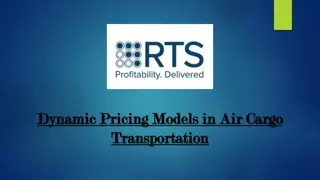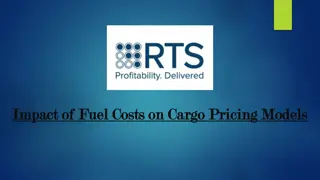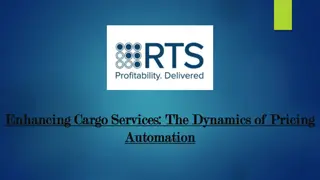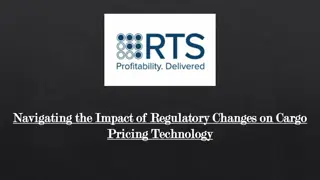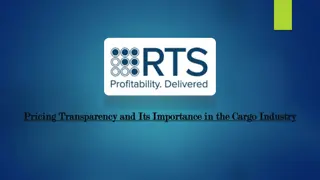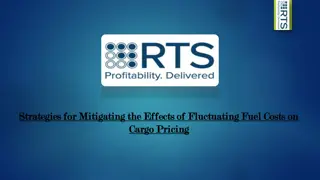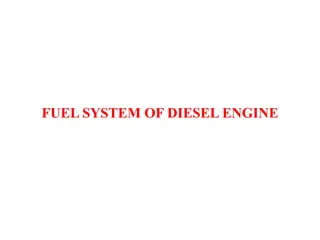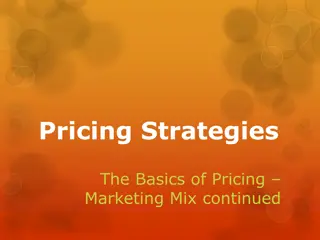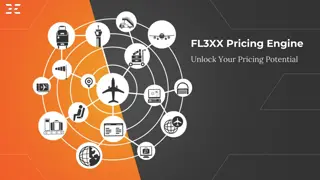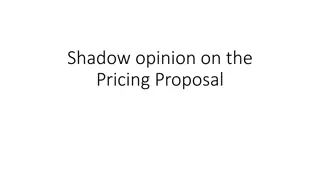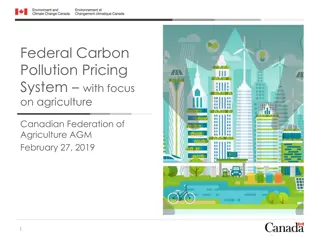Fuel Pricing Mechanisms and Regulatory Framework Presentation
This presentation to the Portfolio Committee on Mineral Resources and Energy delves into the Basic Fuel Price (BFP) for liquid fuels, covering global fuel pricing forms, policy positions, key pricing mechanisms, regulatory mandates, and the intricate structure behind fuel prices. It explains how the BFP is determined based on import parity pricing principles, local and international factors affecting fuel prices, and regulatory systems governing the pricing mechanisms. The presentation aims to provide clarity on the complexities of fuel pricing to facilitate informed decision-making.
Download Presentation

Please find below an Image/Link to download the presentation.
The content on the website is provided AS IS for your information and personal use only. It may not be sold, licensed, or shared on other websites without obtaining consent from the author.If you encounter any issues during the download, it is possible that the publisher has removed the file from their server.
You are allowed to download the files provided on this website for personal or commercial use, subject to the condition that they are used lawfully. All files are the property of their respective owners.
The content on the website is provided AS IS for your information and personal use only. It may not be sold, licensed, or shared on other websites without obtaining consent from the author.
E N D
Presentation Transcript
PRESENTATION TO PORTFOLIO COMMITTEE: MINERAL RESOURCES AND ENERGY BASIC FUEL PRICE (BFP) 12 APRIL 2021
PRESENTATION OUTLINE Introduction Policy position and key pricing mechanism The Basic Fuel Price (BFP) for liquid fuels International Factors Local Factors included in the Prices of Fuel Prices Fuel Price Breakdown Structure Regulatory Accounting System (RAS) Recap Frequently asked questions End
INTRODUCTION Three basic forms of fuel pricing globally Ad hoc pricing - Prices set irregularly, No transparency common in countries that have own oil (highly subsidized) {It is an illusion keeping the prices constant even when the markets are bullish, hoping that the prices will go down e.g. Bolivia.} Formula based / automatic pricing adjustments Prices are published (but not the formulas in some countries) e.g. RSA publish both prices and the formula Liberalised pricing system the market set the prices (depoliticized) but there is a formula e.g. Australia. {The Australian Competition and Consumer Commission (ACCC) act as a watchdog to ensure that there is no price collusion}
POLICY POSITION AND KEY PRICING MECHANISM Regulation of liquid fuels prices Petrol, diesel and illuminating paraffin (IP) Liquefied Petroleum Gas (LPGas) for households since 14 July 2010 Import parity principle (IPP) applies Dfn: IPP is the price an importer has to pay to purchase a product in the world market and have it delivered for domestic sale. Deemed pricing Zonal pricing magisterial district zones (MDZ) Transport modes based on least cost mode Cost recovery - Pass through cost
POLICY POSITION AND KEY PRICING MECHANISM Regulatory Mandate Energy White Paper on Energy Policy of November 1998 Petroleum Products Act, 1977 (Act No.120 of 1977); Central Energy Fund Act, 1977 (Act No. 38 of 1977); Gas Act, 2001 (Act No. 48 of 2001); Petroleum Pipelines Act, 2003 (Act No.60 of 2003); Gas Regulator Levies Act, 2002 (Act No. 75 of 2002); Petroleum Pipelines Levies Act, 2004 (Act No. 28 of 2004); National Energy Regulator Act, 2004 (Act No. 40 of 2004); and National Energy Act, 2008 (Act No. 34 of 2008)
THE BASIC FUEL PRICE (BFP) FOR LIQUID FUELS The Basic Fuel Price (BFP) is based on the import parity pricing principle i.e. what is would cost a South African importer of petrol to buy the petrol from an international refinery, transport the product from that refinery, insure the product against losses at sea and land the product on South African shores. NB: The Central Energy Fund (CEF) (Pty) Ltd was appointed by Cabinet in 1994 as an impartial body to determine BFP (prevent manipulation by any interested party) Daily and average monthly BFP for price regulated fuels are calculated by (CEF) in terms of the Working Rules to administer the BFP Monthly BFP calculations, price changes to be effected and monthly Fuel Price Media Statement audited by independent auditors appointed by the DMRE
THE BASIC FUEL PRICE (BFP) FOR LIQUID FUELS Basic Fuel Price Working Rules Make provision for all grades of petrol, all grades of diesel and illuminating paraffin (IP) BFP is adjusted on the first Wednesday of a month Over/under recoveries incurred in a fuel price review period are cleared in the next one Important months April transport tariffs, fuel levy and RAF adjustments September Forecourts attendants wage adjustments December wholesale and retail margins adjustments including secondary storage and transport Quarterly Octane differential adjustments
THE BASIC FUEL PRICE (BFP) FOR LIQUID FUELS Elements of the BFP Free-on-Board (FOB) - value Freight and Average Freight Rate Insurance Ocean loss Demurrage Cargo Dues Coastal Storage Stock Financing costs
THE BASIC FUEL PRICE (BFP) FOR LIQUID FUELS Elements of the BFP Free-on-Board (FOB) Platts: A price reporting agency. Mean quoted FOB-values used Petrol: 50% MED (USD/ton)+50% Singapore (USD/bbl) Diesel: 50% MED (USD/ton)+50% AG (USD/bbl) IP: 50% MED (USD/ton)+50% Singapore (USD/bbl) NB: Argus and Bloomberg are other agencies
THE BASIC FUEL PRICE (BFP) FOR LIQUID FUELS REFERENCE MARKETS
THE BASIC FUEL PRICE (BFP) FOR LIQUID FUELS Elements of BFP Freight and Average Freight Rate London Tanker Brokers Panel MR Vessel: 35,000 to 39,999 tons Average of 37,499.5 tons used in calculation Freight costs: Petrol: 50% Med+50% Singapore Diesel: 50% Singapore+50% AG IP: 50% MED+50% AG NB: 15% premium to supply RSA
THE BASIC FUEL PRICE (BFP) FOR LIQUID FUELS Elements of BFP Insurance Ocean Loss and Cargo Dues Insurance=0.15% of (FOB-value+ Freight) CIF-value=[Costs(FOB)+Insurance]+Freight Ocean Loss= 0.3% of CIF-value Cargo dues= Tariff set by the National Ports Authority
THE BASIC FUEL PRICE (BFP) FOR LIQUID FUELS Elements of BFP Demurrage Demurrage is the time spent in a harbour to load and discharge a cargo - hourly rent of vessel, but not operating Demurrage rate: World Freight Rate Association Rate for petrol:50%MED+50% Singapore Rate for diesel and IP: 50% Singapore+50% AG Days allowed: 3 days in total
THE BASIC FUEL PRICE (BFP) FOR LIQUID FUELS Elements of BFP Coastal Storage and Financing Assessed at $3/bbl or 2.5 SA c/l per month 25 days allowed for storage =2.038 SA c/l Adjusted annually in line with the movement in the Producer Price Index (PPI) {CS=PPIn/PPIb*2.083 c/l} Interest rate: Standard Bank s prime interest rate less 2% SFC= [LCV*(PR-2)*25/365] LCV: Landed Cost Value PR: Prime Interest Rate
OTHER INTERNATIONAL FACTORS THAT INFLUENCE THE BFP International crude oil prices International product supply/demand balances Product inventory levels Geo-politics Rand/US Dollar exchange rate International refining margins Weather patterns in the Northern Hemisphere NB: CEF website: www.cefgroup.co.za
SUMMARY OF INTERNATIONAL FACTORS Average exchange rate: USD1=R14.98 Average FOB: 630.146 c/l Freight rate and AFRA: 23.316 c/l Demurrage: 0.853 c/l Insurance: 1.017 c/l Ocean Leakage: 2.036 c/l Cargo dues: 3.244 c/l Coastal Storage: 5.673 c/l Stock financing costs: 3.749 c/l International conversion factors used
LOCAL FACTORS INCLUDED IN THE FUEL PRICES Fuel Levies (1) Petroleum products levy: to reimburse the pipeline users for the applicable NERSA tariff on transporting fuel through the pipeline - levy set by the Ministers of Energy and of Finance in line with the expenditure budget of NERSA IP Tracer dye levy: to reimburse the oil industry for buying IP tracer dye and to inject it into IP to curtail the mixing of IP and diesel (loss to the Fiscus) Slate levy: to finance the cumulative under recovery of the industry. Only applicable when the cumulative Slate balance exceeds R250 million (under recovery)
LOCAL FACTORS INCLUDED IN THE FUEL PRICES Fuel Levies (2) Fuel levy: Tax levied by Government (Minister of Finance) Custom and Exercise levy: a duty collected in terms of the Customs Union Agreement Road Accident Fund (RAF) levy: To compensate for people involved in vehicle accidents. Demand Side Management levy (DSML): Introduced in 2006 to curtail the use of ULP 95 in the inland market.
FUEL PRICE BREAKDOWN STRUCTURE PETROL & DIESEL Petrol 95 ULP (c/l) (c/l) Wholesale margin 40,500 Secondary Storage 27,200 Secondary Distribution 15,800 Router Differential 0,000 Retail margin 221,600 Petrol 93 ULP Diesel 0.05% S (c/l) Diesel 0.005% S (c/l) 77,660 27,200 15,800 0,000 0,000 IP (c/l) 40,500 27,200 15,800 0,000 221,600 77,660 27,200 15,800 0,000 0,000 77,660 27,200 15,800 7,400 0,000 Zone differential in Gauteng IP Tracer levy Fuel levy Customs & excise duty RAF levy Petroleum Products levy Slate levy DSML Pump Rounding Sub-total 64,900 0,000 393,000 4,000 218,000 0,330 0,000 10,000 0,500 995,830 64,900 0,000 393,000 4,000 218,000 0,330 0,000 0,000 0,500 985,830 64,900 0,100 379,000 4,000 218,000 0,330 0,000 0,000 64,900 0,100 379,000 4,000 218,000 0,330 0,000 0,000 85,300 0,000 0,000 0,000 0,000 0,000 0,000 0,000 786,990 786,990 213,360 Basic Fuel Price Contribution Retail Price Wholesale price 636,170 1 632,00 629,170 1 615,00 625,430 629,830 632,328 1 412,420 1 416,820 845,688
FUEL PRICE BREAKDOWN STRUCTURE - ILLUMINATING PARAFFIN (IP) Price Component Cents per litre Basic Fuel Price 632.33 Wholesale Margin 77.66 Service Differential 43.00 Router Differential 7.40 Transport costs 85.30 Sub-Total 845.69 Retail Margin (33.3% of Sub-Total) 281.62 SMNRP 1127.31
FUEL PRICE BREAKDOWN STRUCTURE - ILLUMINATING PARAFFIN Illuminating Paraffin Pie Diagram
FUEL PRICE BREAKDOWN STRUCTURE - MAXIMUM RETAIL PRICE OF LIQUEFIED PETROLEUM GAS (LPGAS) Coast Inland Price Element Zone 1A Zone 9C Maximum refinery gate price 1 137,895 1 137,895 Primary transport costs 47,588 225,582 Operating expenses 464,757 464,757 Working capital 35,228 35,228 Depreciation 173,648 173,648 Gross margin: Cylinder filling plant 221,883 221,883 Subtotal (1) 2 080,999 2 258,993 Retail Margin: (15% of Subtotal (1)) 312,150 338,849 Subtotal (2) 2 393,149 2 597,842 Value Added Tax (15% Subtotal (2)) 358,972 2 752,000 389,676 2 988,000 Maximum Retail Price (Rounded to full cents
FUEL PRICE BREAKDOWN STRUCTURE - MAXIMUM RETAIL PRICE OF LIQUEFIED PETROLEUM GAS (LPGAS) LPGas Pie Diagram
REGULATORY ACCOUNTING SYSTEM (RAS) Margins on activities are based on Regulatory Accounts Activities post-refinery gate are ring-fenced Assets, costs and ROA are ring-fenced to that activity ABC methodology CAPM and WACC are applied to determine the ROA of each activity Identified activities were: Wholesale activities Secondary storage Secondary distribution Service station retail activities (BSS)
RECAP Petrol is regulated at retail level Diesel is not regulated, the Department publishes the wholesale reference price Illuminating Paraffin is regulated at retail level (SMNRP) LPGas is regulated at Retail level and the MRGP is determined by government Industry margins are determined by using the Regulatory Accounting System (RAS) methodology
FREQUENTLY ASKED QUESTIONS (FAQS) 1. Why are the fuel prices changing every month? 2. What is over (under) recovery? 3. Why is petrol cheaper in neighboring countries and yet they purchase it from RSA? 4. Why is SASOL not selling petrol at lower prices because they produce it from coal? 5. Why is the government not deregulating fuel prices? 6. Why is ULP95 more expensive than ULP93 in GP, but the cost the same price in coastal areas? 7. Why is the government not buying oil from African countries at lower prices?



